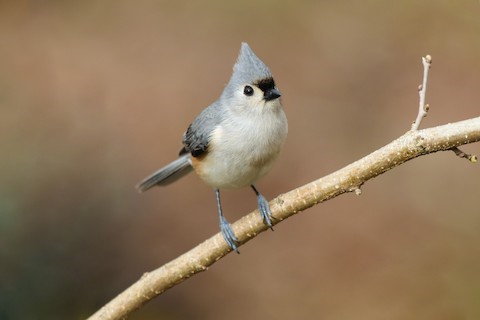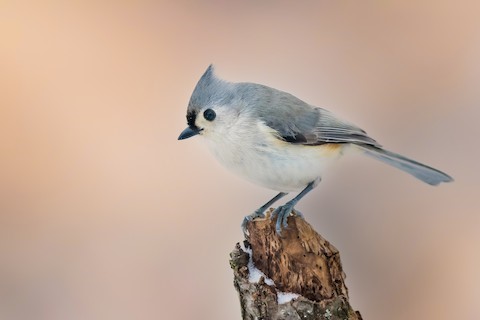Birdfinding.info ⇒ One of the most abundant and familiar songbirds of the eastern U.S., it is among the principal attendees of backyard bird feeders from the Great Lakes and New England states to central Texas and southern Florida. For a more detailed view of its distribution, see Breeding Bird Survey Abundance Map in Notes, below.
Tufted Titmouse
Baeolophus bicolor
The Carolinian Forest region of the eastern U.S.
Resident in deciduous and mixed woodlands, including suburban and urban neighborhoods, throughout most of the eastern U.S., north to southeastern Minnesota, central Wisconsin, the lower peninsula of Michigan, and all of New England (but sparse or sporadic in northern Maine), west to eastern Nebraska, Kansas, Oklahoma, and Texas, and south to the central Texas coast and southern Florida.
Also an uncommon resident of neighboring parts of Canada from southern Ontario east to the vicinity of Quebec City, then sparsely or sporadically farther east along the St. Lawrence River and into New Brunswick.
Identification
Distinctive: a gray songbird with a peaked crest and a strikingly prominent black eye that is accentuated by a black partial eyering.

Tufted Titmouse. (Kensington Metropark, Michigan; January 16, 2015.) © Darlene Friedman
Lead-gray above, with a black forehead and a pale face that contrasts with its eye. Whitish below, with a cinnamon wash on the flanks.
Overlaps marginally in Texas and Oklahoma with the closely-related Black-crested Titmouse—which is similar but has the reverse color pattern on its forehead and crest. Hybrids with blended features are fairly common in the overlap zone.

Tufted Titmouse, showing pronounced black forehead contrasting with gray crest. (Finksburg, Maryland; April 3, 2020.) © Forrest Baublitz
Notes
Monotypic species. Formerly considered conspecific with the Black-crested Titmouse (atricristatus).
Breeding Bird Survey Abundance Map: Tufted and Black-crested Titmice (combined).

References
Alderfer, J., and J.L. Dunn. 2014. National Geographic Complete Birds of North America (Second Edition). National Geographic Society, Washington, D.C.
BirdLife International. 2016. Baeolophus bicolor. The IUCN Red List of Threatened Species 2016: e.T22711983A94314102. https://dx.doi.org/10.2305/IUCN.UK.2016-3.RLTS.T22711983A94314102.en. (Accessed February 5, 2022.)
eBird. 2022. eBird: An online database of bird distribution and abundance. Cornell Lab of Ornithology, Ithaca, N.Y. http://www.ebird.org. (Accessed February 5, 2022.)
Harrap, S., and D. Quinn. 1995. Chickadees, Tits, Nuthatches & Treecreepers. Princeton University Press.
Sibley, D.A. 2014. The Sibley Guide to Birds (Second Edition). Alfred A. Knopf. New York.
Xeno-Canto. 2022. Tufted Titmouse – Baeolophus bicolor. https://xeno-canto.org/species/Baeolophus-bicolor. (Accessed February 5, 2022.)

